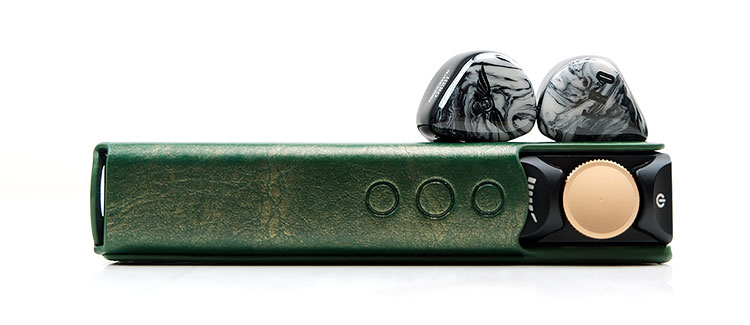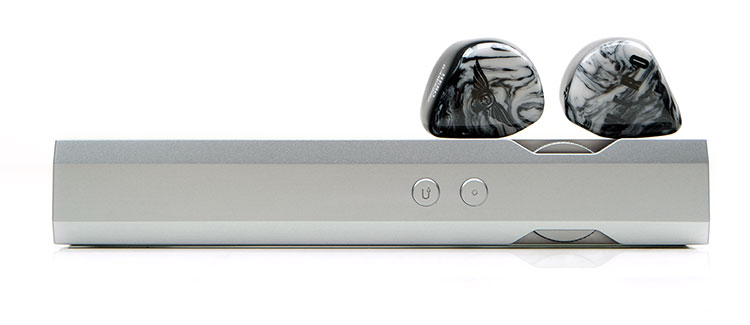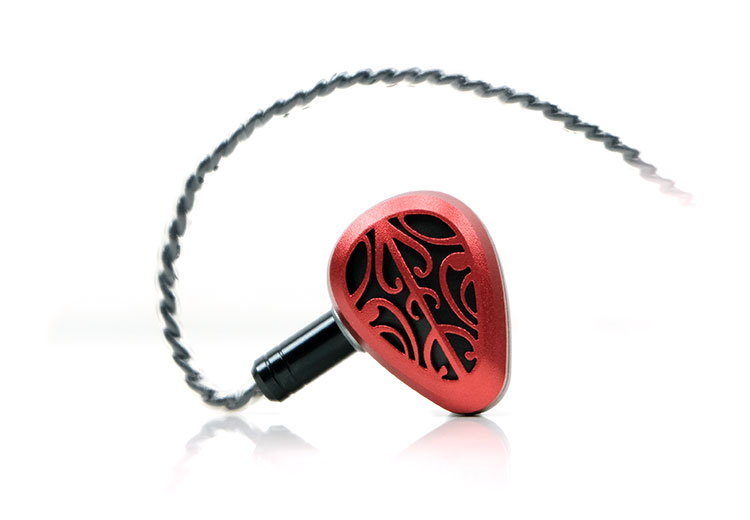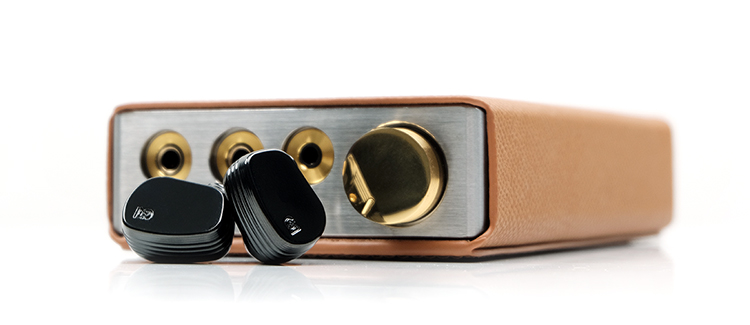Sound Impressions
Summary
The Hero has one of those sound signatures that as a reviewer I find incredibly easy to describe and understand. This is an out and out V-shaped tuning but one that I think is done incredibly well and is an absolute blast with the right music or genre.
The whole presentation is refreshingly honest and by that I mean, it takes no prisoners, does not mess around, and should present no problems to potential buyers in terms of “will it work with this or not” kind of questions.
The V in the Hero has a decided sub-bass thump and energetic treble bias as you might expect and both have a really nice high-contrast balance at least for my own personal preferences when it comes to this type of coloration. There isn’t so much of a mid-bass emphasis such as you might find on the darker 64 Audio Nio so there is less warmth traveling up into the mids.
Combined with a steep drop into the lower-mids up to around 1k you do get less presence and richness for instruments and vocals but the power from the Weapon IX+ dynamic driver remains with an exciting bass fundamental underpinning the notes.
Vocals
Vocals are a game of two halves with the Hero. Because of the dip in the lower-mids, you might fund lower-pitched or chesty male vocal pitches to lack a little texture and grit as well as presence. It will sound clean, however, with a high level of bass/treble contrast but the dominance of the Weapon IX+ will push it back a fair bit.
You get quite the opposite effect with higher-pitched vocals or those that hit around 1-3k which sound pristine, forward, and dynamic in their delivery. You go get a bit more of an odd harmonic influence in those vocals from the Hero’s peppy treble delivery so the overall tone will be brighter than liquid.
That does not automatically mean sibilance; however, it can creep in on overly bright recordings but I found it to reside more in the percussion energy than specifically vocal presence. Vocals seem to be more finely balanced, often with an almost ethereal sweetness and sheen to them so out and out sibilance might be more source and ‘recording specific’.
Timbre
The Hero offers a high contrast type of timbre with a heavy emphasis on low-end power and treble energy. Overall, that means a clean and cool timbre, especially in the mids, but the exact balance will vary depending on the pitch of the instrument or vocal.
On the low-end, you get some excellent bass texture and a natural sounding but slightly longer rate of decay that reaches deep with ease.
Notes touching on this region are going to bounce along with ease offering a very planted sound with plenty of ‘drive’. It’s the type of tuning that works wonderfully well in teasing out that essential rhythm to give R’n’B tracks that signature underlying groove.
Towards the upper mids, you get less of that dynamic driver influence and more of a BA texture but also that signature BA articulation. It’s more articulate, a little drier with percussion, and a lot more odd-harmonic influenced so definitely brighter and more vivid in its delivery.
As mentioned, the bite in the forward treble of the Hero does seem to fall more on percussion than all but the more screechy of vocal performances. Without the percussion energy in full flow, the Hero’s falsetto and head voice timbre combined with its 1-3k bump can often sound delicate yet intoxicatingly sweet in their delivery.
Staging
The Hero’s has a very tall and deep soundstage but one also that is stretched over a beautiful black background. That cleaner timbre from the mids up to the treble combined with a lack of mid-bass bloom allows for a very enjoyable level of instrumental separation.
That excellent separation plays right into the hands of the 1-3k vocal presence bump which stretches the stage really well placing a lot of soulful head and mixed voice in the foreground.
There is nothing worse than a recessed 2-4k region with veiled vocals or a dark signature if you plan on upping the bass levels in a presentation. The Hero does an excellent job of keeping disciplined when it comes to imaging the stage from front to back.
The one caveat would be for those looking for meat and body or a strong chest voice presence. The dip in the lower-mids will lean it out and push the presence back in deference to the bass weighted kick drum power and upper-mids percussion energy.
It’s not a diffuse sound, there is plenty of clarity. Rather, those raw guttural vocal snarls from the likes of Ivan Moody, one of my favorite metal lead singers, lacks a little authority and sounds much further back imaging wise.
Synergy
Efficiency
The Hero is rated at 17.5Ω and 105dB SPL which, after a few straight years of doing hybrid reviews, seems to me about the mean SPL rating for most. That means the Hero is pretty easy to drive and with that dynamic driver being less prone to impedance skew from high impedance output DAPs if any are still doing the rounds in 2020.
It is less efficient compared to Campfire Audio monitors but then so is pretty much everything else is outside of Vision Ears in my experience. That does mean that the Hero will pair very well indeed with the likes of HiBy’s excellent R8 DAP, Cayin’s N6ii with the balanced E02 motherboard, and FiiO’s M15.
If you are used to something like the 64 Audio Nio with its similar 105dB SPL rating then the Hero is going to perform to a similar level. I advise a source with a resolving output and one with good dynamic range but low-gain is all you will need to power the Hero.
Pairings
Ultimately this will depend on what you want to get out of the Hero in terms of timbral coloration or bias to a certain presentation. Testing was done with 5 DAPs that ranged from the neutral and clean M15 to the warmer and fuller R8, Cayin N6ii/E02, and the analog performance of the LP P6. We also threw in the N3Pro just to see how the unique tube sound would affect the pairing.
Bass Synergy
What I found was that certain DAPs sat better with the Hero for certain aspects of the general performance. Surprisingly, the FiiO M15 was an enjoyable bass performer over some of the competing DAPs. Not in terms of quantity, but rather in terms of layering and definition. It felt tight, fast, and very nicely extended compared to the softer E02 performance on the N6ii.
The HiBy R8 also added a similarly warm and full-bodied bass coloration to the N6ii/E02 but again, the M15 just had that extra something that made it more enjoyable for low-end articulation.
Vocal Synergy
On the flip side, the M15 did not really open up the mids and vocals as much as the R8 and the E02 which offered a bit more of a sweeter timbre and forward vocal presence. Also, the pace felt a little more relaxed on the E02 and R8 with a little less treble energy which some might prefer.
The N3Pro in single-ended Ultralinear mode was a really nice pairing if you want to ease back on the bass levels using the Hero and bring out the vocal presence a bit more. Treble is not that hot though still quite lively. Triode tube mode lost a little of the Hero magic for me with the lack of openness in the mids.
The LP P6 mixed the separation and definition of the low-end from the M15 and also offered a nice analog tone to the Hero mids and treble.
Importantly, it added some really nice, detailed texture to the Weapon XI+ driver to go alongside that control. Vocal’s also sounded more realistic on the P6 and it is relaxed enough on the top end to keep the more energetic quirks of the Hero in check.
Select Comparisons
MMR Gae Bolg
$1199
The MMR Gae Bolg was a recent review from us with a striking Celtic-inspired design and a relaxed natural to warm sound signature.
Technical
The configuration is quite different with an all-BA design with a dual vented bass BA for the lows, a single full-range BA with bandpass for the mids, a vented BA for the mid-highs, and a tweeter for the highs.
That is 5 drivers in total all pieced together using MMR’s new patented 4-way Electro Frequency Division crossover.
The Hero also uses a 4-way crossover but its EE’s patented synX Crossover Network and is also a hybrid monitor with a single W9+ 9mm dynamic subwoofer for the lows and 3 proprietary BA for the mids and highs. You are going to get a vastly different type of texture and response from these two monitors.
The Gae Bolg is rated at 25Ω with an SPL rating of around 98dB SPL compared to the Hero more sensitive 17.5Ω and 105dB SPL rating. Neither are what I would term super-sensitive like Campfire Audio or some of Vision Ear’s creations but neither are that hard to drive with decent DAPs.
Noise is not an issue with either monitor but a direct comparison using the balanced output of the M15 did make me feel the Hero was better equipped to handle any potential hiss but it is very marginal.
Design
Massively different approaches with the Gae Bolg an aesthetical masterpiece with that finely sculpted red CNC aluminum 3-dimensional faceplate that even the tidy Black Tide plating of the Hero would struggle to outshine.
However, in terms of fitting and isolation, the Hero’s contoured lightweight acrylic shell and decent nozzle length do make it more comfortable to wear.
Despite the venting, the Hero actually has a competitive level of isolation compared to the non-vented Gae Bolg. Whilst tips do play a role, the greater factor here is the more accurate contouring on the Hero versus the more uniform shaping of the metal housing of the Gae Bolg.
The stock cable of the Gae Bolg is 4-core SPC compared to the Alpha-IV 26AWG UPOCC Copper Litz Cable on the Hero. The Alpha-IV is the better cable in terms of dynamic range and resolution but the small MMR cable is quite a bit lighter. You can upgrade to an Eletech cable with the Gae Bolg at the checkout but sadly we do not have one here to compare.
Performance
A really big difference between these two in terms of sound signature and to be honest, it’s a case of chalk or cheese.
The Hero is much taller, deeper, and more powerful sounding with its Weapon IX+ dynamic driver’s heavy sub-bass bias. It is also far airier, with more treble presence and energy as well as offering superior headroom.
The Gae Bolg’s is full-bodied for a BA configuration on the low-end but does not reach as deep as the Hero, nor does it offer a huge sub-bass presence. It is more mid-bass punchy with a bit of warmth traveling upwards and a decidedly BA texture to its bass. It also has a more relaxed and forgiving treble signature sounding more liquid but with less headroom or sparkle.
The Gae Bolg’s strength is more in the lower-mids and vocal presence, exactly where the Hero is at its comparative weakest in terms of presence and body. That V-shaped curve of the Hero sucks out the lower-mids warmth and richness leaving a cooler timbre and lighter note. This is a mids timbre with a lot more bass/treble contrast or lowest/highest harmonic order dominance.
Comparatively speaking, the Gae Bolg only has a minor dip into the lower-mids and a bit of a boost around 1-2k pushing forward a much warmer and richer male vocal. It creates a more intimate staging presentation as a consequence with better vocal presence. The mids timbre here is more second order, even harmonic, and slightly euphonic in tone.
I would pick the Gae Bolg if vocals are more important to you with that intimate rich mids tone. However, if you need more staging presence, power, and air then the Hero is the right choice.
64 Audio Nio
$1699
The Nio is a recent hybrid monitor release from 64 Audio and is priced a little higher but I personally think a lot of people will be studying this and the Hero as potential options because they do have some strong coloration.
Technical
The Nio is also a 4-way crossover hybrid design but this time we are looking at 9 drivers instead of 4 inside the Hero. The Nio configuration is a single 9mm dynamic driver for the lows, 6 BA for the mids, 1 BA for the high-mids, and one tia BA for the highs.
By contrast, the Hero has a similar DD size at 9mm but perhaps a slightly superior dynamic driver in the form of the Weapon IX+. On top, just 3 proprietary BA for the mids and highs.
Both companies have a lot of their own designed tech inside that is unique to each with the Nio using apex module filtering, tia tubeless for the highs, and LID for impedance balancing. The Hero uses its Weapon IX+ subwoofer technology, patented 4-way synX Crossover Network, as well as A.R.C. for the purposes of enhancing clarity and the bass response of the Hero.
The Nio is rated at a very low 6Ω and 105dB SPL compared to the Hero at 17.5Ω and also 105dB SPL. In truth, neither will require that much power, and both seem to have similar levels of efficiency. If you find yourself driving up the Nio volume to match it’s probably more to do with compensating for the stronger treble presence on the Hero which will give it a livelier sound.
Design
Both the Nio and the Hero have some exquisitely designed faceplates with the Nio using a blue Abalone polished aesthetic and the Hero going for that noire Black Tide vibe. Both are distinct in their own ways.
Underneath, however, they are quite different with the Nio opting for 64 Audio classic 2-piece shell design crafted from a solid block of aluminum. This is a smooth finish with clean lines and a polished black main shell finish with chrome fenders.
The lighter black acrylic hollow body finish for the Hero does mean it is lighter, however. It also has more aggressive contouring making it a slightly more comfortable fit but the difference is not huge.
The isolation on both really depends on the Nio apex filter in use as it comes with 3 and each vent a little more or less than the other. I would place the Hero on the same level as the m15 apex module.
The Nio has a decent stock cable. This is a 48″ wire with an ultra-low resistance silver-plated copper (SPC) and a tight black jacket called the Premium cable. However, it is not quite the dynamic performer compared to the Alpha IV and the finishing is a little more basic.
Performance
Both of these monitors have a fairly strong low-end dynamic driver performance, however, the Nio is not quite as sub-bass biased and holds a bit more presence into the mid-bass so you get an equal mix of power and warmth.
The Hero is much more sub-bass orientated with less mid-bass presence and warmth. You get even more power compared to the Nio but less mid-bass warmth and a stronger dip into the lower-mids resulting in less instrumental richness.
On the flip side, the Nio offers less treble energy and is not as forward and energetic sounding from the upper mids around 4k right through to 10k. The Hero offers much more contrast into its timbre, with an explosive mix of power and brightness compared to the Nio’s darker and warmer tones.
That contrast also places a different emphasis on vocal timbre. The Nio’s vocal performance is are wet, rich, and sibilant free both male and female, and also with a slightly rounded tone due to the relaxed treble. The Hero vocals are feistier, brighter, and cleaner with female vocals much to the fore. However, male vocals straddling below 1k have less presence and sound a bit thinner.
Both have an excellent technical capability but again, this is a preference thing. If you like good low-end dynamic range timbre but need a more forgiving and slightly darker tone then the Nio is a good pick. If you want to ramp up the power even more and introduce more air and treble energy into the mix then the Hero is the more logical pairing.
Campfire Audio Solaris 2020
$1499
The Solaris 2020 probably does not need much of an introduction in terms of the who, what, where, and why but suffice to say it is a tweak of their flagship hybrid from 2018 and a follow-on from the SE version we reviewed earlier in the year.
Technical
The Solaris 2020 is a hybrid universal monitor with a quad driver configuration consisting of a 10mm dynamic driver with a Carbon (A.D.L.C.) Diaphragm for the lows and mids, a custom full-range BA for the mids, and a dual tubeless BA configuration (T.E.A.C.) for the highs.
The Hero is also a quad driver hybrid but a slightly different configuration consisting of a 9mm Weapon XI+ for the lows, 2 BA for the mids, and a single BA for the highs. It also uses a dedicated crossover (4-Way synX Crossover Network) whereas the Solaris only uses a single crossover for the mids to highs and the lows to mids ‘roam free’.
The Solaris 2020 is very efficient even though its rating is a little harder to compare with given CA have switched to a Vrms to 84dB SPL benchmark. The previous Solaris from 2018 was rated at 10Ω and 115dB SPL so there is no reason to think the 2020 edition has deviated massively from that spec.
Suffice to say the Hero is marginally harder to drive but plays better with higher noise floors whereas the Solaris 2020 will pick up some background hiss, especially if going balanced with the likes of the FiiO M15 and HiBy R8.
Design
The Solaris 2020 is quite a contrast to the Hero design with its very durable all-black PVD Finished and use of solid metals compared to the lightweight acrylic materials of the Hero. Both have a noire look though the Hero Black Tide design is more engaging than the Solaris 2020’s monotone dark vibe.
Had this been 2018 I would have said no contest in terms of comfort and isolation as the Solaris fit is very big and a little uncomfortable. Well, the 2020 Edition directly addresses that with a much smaller form factor and a lighter design that makes it very competitive in terms of comfort.
Still not to the level of the Hero though. There are some benefits with acrylic designs and lack of weight combined with better contouring is one of them.
The metal body shape of the Solaris 2020 also means a slight diminution in terms of passive isolation compared to the Hero but the gap is not huge. Both have venting so neither will isolate as good as a form-fitting non-vented BA design.
Performance Bias
The Hero is much more V-shaped than the Solaris 2020 which I feel is a bit more controlled on the low-end and relaxed on the top end, comparatively speaking.
That is not to say the Hero is not balanced, for a V-shaped it has everything in the right place with just a smidgen more upper mids and treble bias. Rather, I think a lot of people will find the Solaris 2020 less niche, and more flexible for genres that you would not consider the Hero for.
You could say the Hero wears its heart on its sleeve and you will absolutely know what music you are listening to if you enjoy the Hero.
Deviations
The Solaris 2020’s low-end is more evenly controlled but also much less powerful. It has good depth and a nice balance in terms of mid-bass warmth and sub-bass power but compared to the Hero it is a more cautious tone.
The Hero murders it in terms of sub-bass power and also the Weapon IX+ seems to deliver just a little more low-end texture compared to the Solaris 2020 dynamic driver.
Where Solaris 2020 does better is that lower-mids presence. Instrumental notes and male vocals have more body, warmth, and much better presence.
The Hero is very lean and clean with some nice separation in the lower-mids. However, the instrumental note body comprises more of a fundamental and upper harmonic order mix with less even harmonic coloration or warmth. Male vocals below 1k are also much further back in the mix and do not offer the same presence.
Both have a bump around 1-2k but the Solaris bump is quite a narrow band with a drop and even response curve into the treble. The treble also has some nice articulation and good headroom but not the same energy as the Hero.
The Hero takes the treble up a notch or 20 so it is less forgiving but with more sparkle. However, it also does not drop quite as much in the upper mids beyond 2k compared to the Solaris 2020.
Higher-pitching vocals will therefore sound more forward but brighter on the Hero whereas the Solaris vocal will fall back a tiny bit but also sound the more forgiving of the two.
Our Verdict
The Empire Ears Hero is a bit of a welcome tonic to the miserable year that is 2020. This is an honest to goodness V-shaped tub-thumping presentation, heavy on the sub-bass rumble and matching treble energy.
It is exciting, but not without finesse with much better than expected instrumental separation, female vocals clarity, and a dynamic driver with some excellent texture. Some might the treble a bit hot for their tastes but with the right source and relevant genres such as synth wave, modern R’n’B, or Tropical House it is a lot of high-quality fun.
Please do not see the Hero as a reference tool unless you really digging deep for BPM mixing, it is anything but neutral. However, it does exactly what it sets out to do in some style and along with Lime Ear’s Pneuma, I would consider this one of the more enjoyable monitors for simply just letting your decidedly unkempt 2020 self-styled hair down.
Empire Ears Hero Specifications
- 4 Proprietary Drivers, Hybrid Design
- 1 Next Generation W9+ Subwoofer – Sub-Bass/Bass
- 3 Proprietary Balanced Armature Drivers – 1 Mid, 1 Mid-High, 1 High
- 4-Way synX Crossover Network
- A.R.C. Resonance Mitigation Technology
- Impedance: 17.6 Ohms @ 1kHz
- Frequency Response: 5 Hz – 40kHz
- Sensitivity: 105dB @ 1kHz, 1mW
- Handcrafted Alpha-IV 26AWG UPOCC Copper Litz Cable








